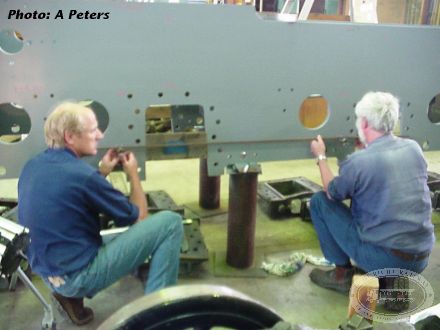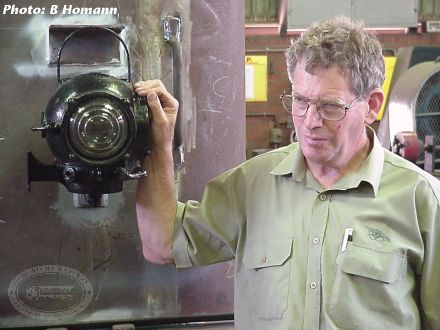Part 20: Various work updates—January 2002
Winding down
To conclude the year 2001, a bar-b-q tea was held at John Lyas' home just prior to Christmas. This was well attened by staff and volunteer workers alike, and a pleasant eat was had. When darkness fell, John's father produced a 16mm projector and screen. After getting a big laugh from a couple of Abbot and Costello golden oldies, we had a look at some excellent footage of NM25 on its last operations in the 20th century (back in the 60s).
Riveting work
As indicated in the December notes, we had decided to give the crown sheet riveting another go. After all the tests, where we were unable to reproduce the pitting problem, the very first rivet inserted in the second round had them. To use a good Aussie expression, "bugga"!
Fortunately it was close to morning tea time, this providing an opportunity to think again. John Lyas made a throw away comment that he thought the last rivets of the first try were not pitted as badly as the rest. It happened that these four rivets were held up manually, using a long lever (Archimedes would have been proud!), whereas the others used an pneumatic "holder up".
Some mental arithmetic whilst gazing into the tea cup indicated that it was probable that we were able to exert more force manually, than with the pneumatic device. In fact, as we had Gordon, one of our sturdy boilermakers, with us, it was decided to try the lever again using the combined efforts of him and John. To our surprise (and great relief) this worked. Quantifying the experiment means that a successful job can be done using 1.6 "Gordon power" on the bar, John being less substantial than Gordon.
This would appear to conclude the rivet experimenting. We can only surmise that the pneumatic holder up had insufficient force, combined with a tendency to bounce in the early stages of the riveting. With the metal being close to melting, perhaps the vibration combined with contraction due to snap contact literally shook the head apart. The firebox tube plate top corner is now securely in place.
Boiler repairs
The copper main steam pipe from the regulator to the smokebox tube plate had to be removed to effect a good braze repair to the collar where the regulator gooseneck attaches.
At present, the joint between the foundation ring and the outer firebox wrapper is being completely seal welded. The reason for this is the concern that weeps might start there after a few steamings. Due to the nature of in-between-the-frame boilers, this area is generally inaccessible for caulking once installed on the loco.
New holes have been drilled and tapped in the foundation ring to provide a means of fitting angles to support the grate side bearers. This will make the grate system in this loco the same in principle as the W class, resulting in the ability to use the same grate fingers in all our coal fired locos.
Machining of the new boiler longitudinal stays is almost complete. Because we did not have ready access to the means of upsetting the ends to provide material for the heads and threads, this was achieved by "pad welding" the ends up to size. After proof machining, these were 100% magnetic particle crack tested.
Marking the frames

Back at Panorama, the main frames have been marked out to identify cylinder, axle and other motion attachment point locations. In the process of doing this we discovered that the welding of the frame had shortened the distance between the driving axle horn cut out and the cylinder centre by about 3/32". To avoid messing with the motion work, the cylinders are being machined with the mounting holes offset to take account of the variation. It is interesting to note that on coolish days when there is some sun radiation into the building, the top of the frame becomes marginally hotter than the bottom. This causes the frame to "hog back" such that the centre supports actually become free of load by up to 1/8".
Work is continuing on the manufacture of the new ash pan and the ash deflector skirt that bolts to the boiler foundation ring. The various angles and assemblies that support the running boards are being fitted to the frames. In most cases, these will be riveted, as per the original. The horn stays are being progressively fitted to the frames. Even here, problems have arisen due to the welding shrinkage of the frame. In the case of one horn, it was found to be considerably "un-flat" where it faces onto the frame. This was due to cracking and subsequent reweld when it was not properly lined up. No doubt the condition of the original frame had a bit to do with this, as the welding would have been done in-situ, probably under difficult access conditions. It is yet another part that has had to be re-worked.

Tender and marker lights
Volunteer input is picking up again after the Christmas recess, with the tender tank being fully sanded down ready for painting. In the near future, more volunteer foundry and riveting work will be happening. Our website "ad" for marker lamps has been successful, with a full complement of 4 now available. It would still be nice to have a spare, so the request is still open.
In early photos, the NM's are frequently shown with a single marker at the front and rear, and sometimes with two at each end. We do not know if this is due to some policy change in CR, a shortage of lamps, or what. If any one knows the answer, we would be delighted to hear from you. Someone suggested that the different usage reflected route indication. Given that the NM's went either north or south over the one route available to them, route indication would seem to be a bit unnecessary. Train ID might be a more plausible reason (goods, passenger etc).
